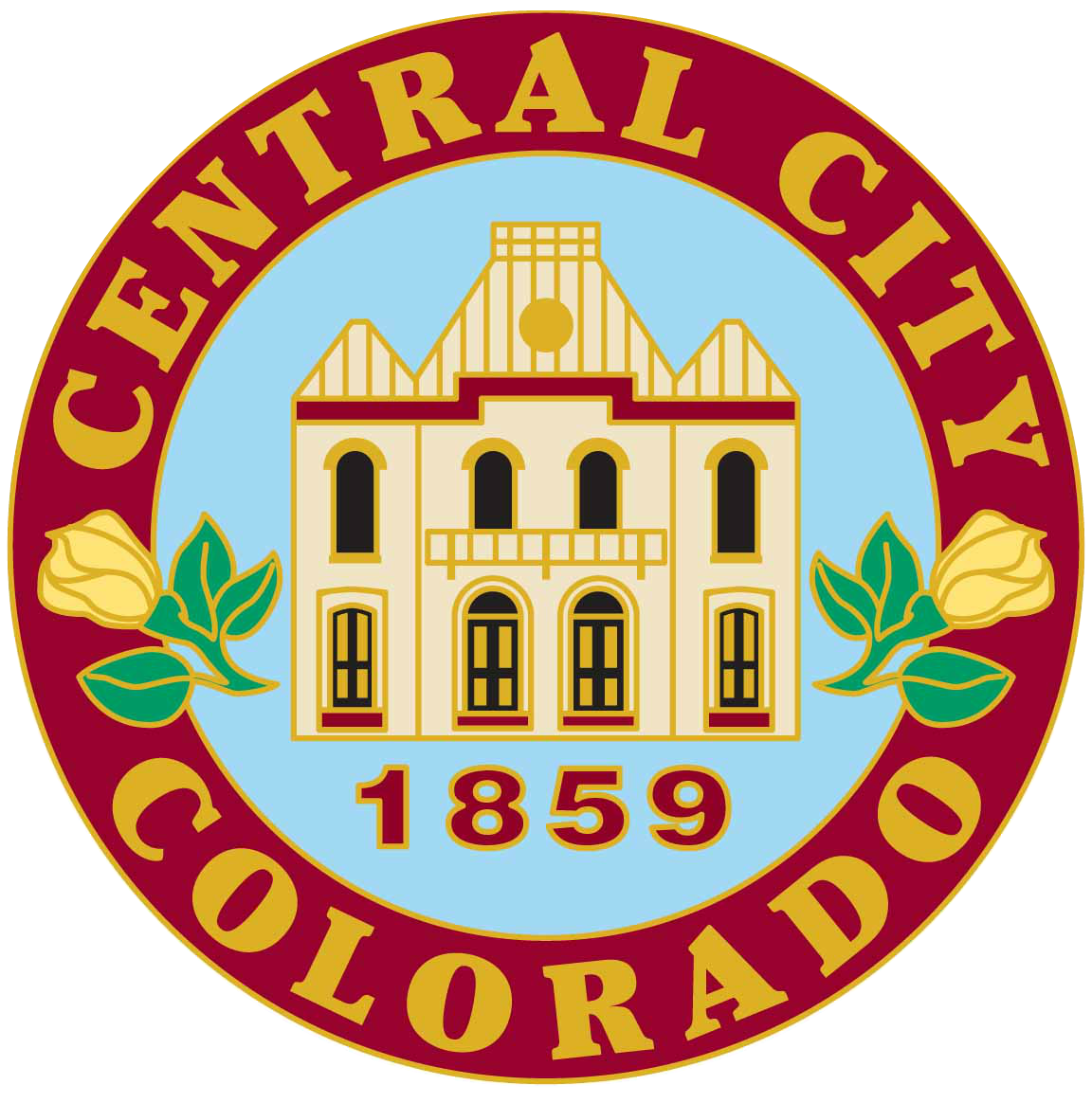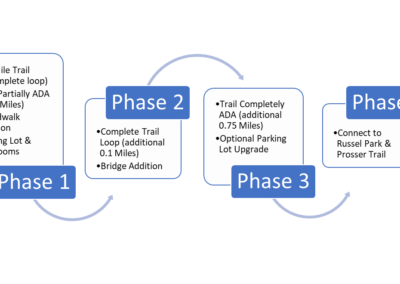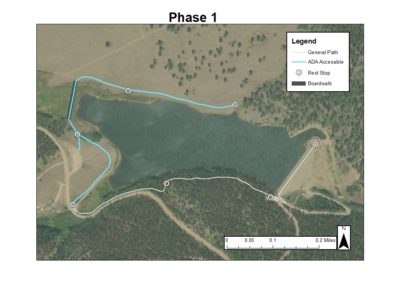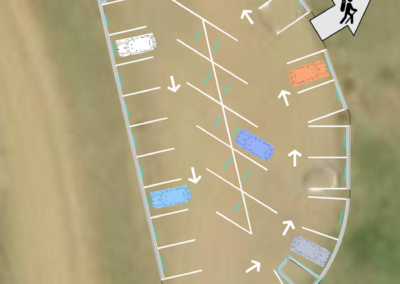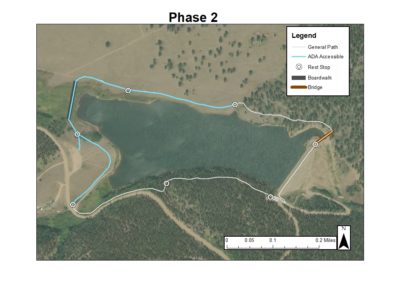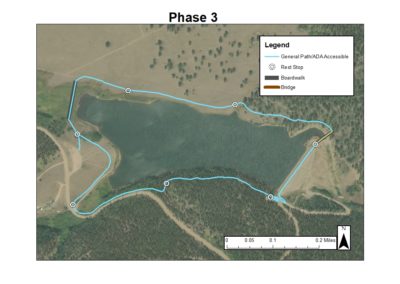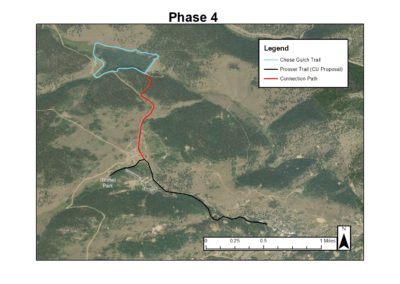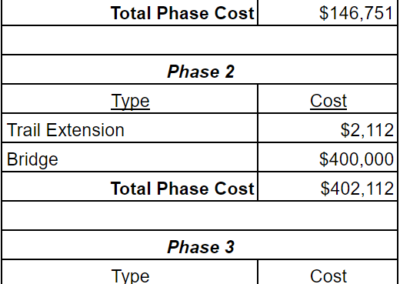Central City Trail Development
Overview
This project focused on the area of Chase Gulch Reservoir in Central City, CO. The reservoir and surrounding area were evaluated to determine possible recreation development options, including a complete path around the reservoir and connection to the nearby Russel Park and the proposed Prosser Gulch development path designed by students from the University of Colorado. This development also includes a public bathroom facility as well as a parking lot restructure. Central City’s stated purpose for this project is to increase the recreation potential of Chase Gulch Reservoir so as to draw visitors and residents to Central City for reasons other than gambling. The main considerations for the trail route were based on ease and effectiveness of establishing ADA accessibility, as well as site feasibility, practicality, and affordability.
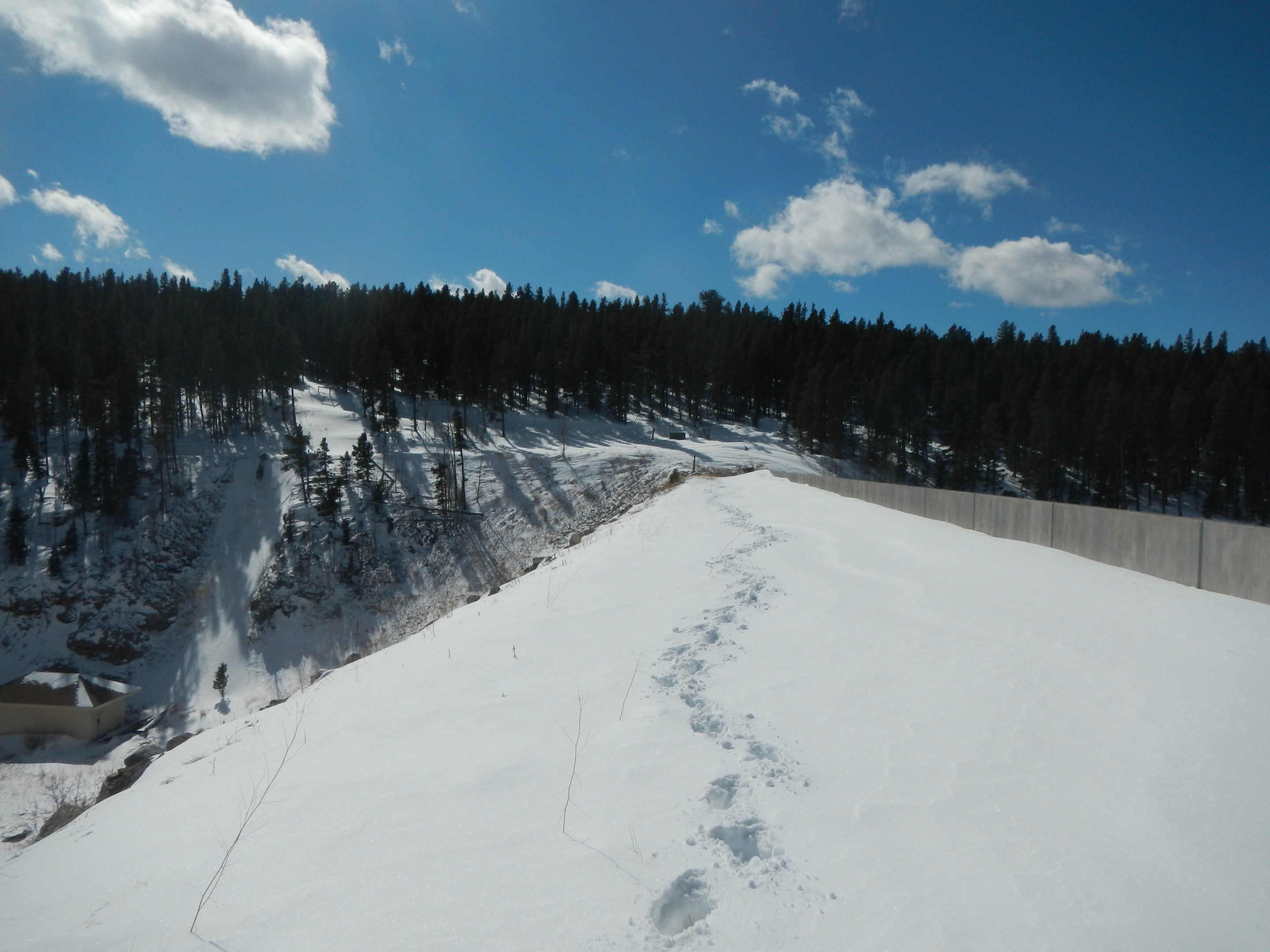
Team Members
- Gina Heinsohn
- Annie Strange
The Client
- Central City, CO
Acknowledgements
Central City supported the students and the Colorado School of Mines in this effort, but does not formally support any findings represented, until further review and consideration is made by the City.
Project Advisor: Dr. Kristoph Kinzli
Technical Advisors: Dr. Ashley Rust, Dr. Andres Guerra, Logan Simpson, Jefferson County Open Space
Additional Support: Kate Spangler, Digital Data Services, group of friendly ice fishers
Elevator Pitch
Design Approach
Frequent communication with our contacts at Central City allowed us to tailor our design throughout the process of the project. This communication included an initial kick-off meeting to meet with the client and ask questions, an intermediate proposal around the half-way point of the semester, and biweekly calls to give updates and receive clarifications and changes.
All the design proposals were based off of data collected from an initial site visit. Location and elevation data were recorded via a GPS device while trekking around the reservoir. Calculations were done with that data and the elevation data produced in Google Earth Pro to verify the accuracy of the Google Earth measurements. The location and elevation data was used in tandem with USGS topographical maps to layout proposed trail routes in both Google Earth Pro and arcMAP GIS. Areas of concern were identified along the routes based on high slope gradients and unstable soil; as both are factors which contribute to more development being needed to insure ADA regulations are met for the entire length of the trail. Soil information was collected from the US Department of Agriculture’s web soil survey. Water samples were also taken from the reservoir and tested for metal concentrations and basic water quality parameters. These results were used as a baseline to ensure that production of a trail would not lead to increased levels of treatment to be required for the water to maintain its drinking water status with the US EPA.
At the intermediate review, three potential routes were proposed and one option was selected to move forward with, along with further guidelines and desires from the client. The final, proposed design is a more developed and refined version of the option chosen in the intermediate review.
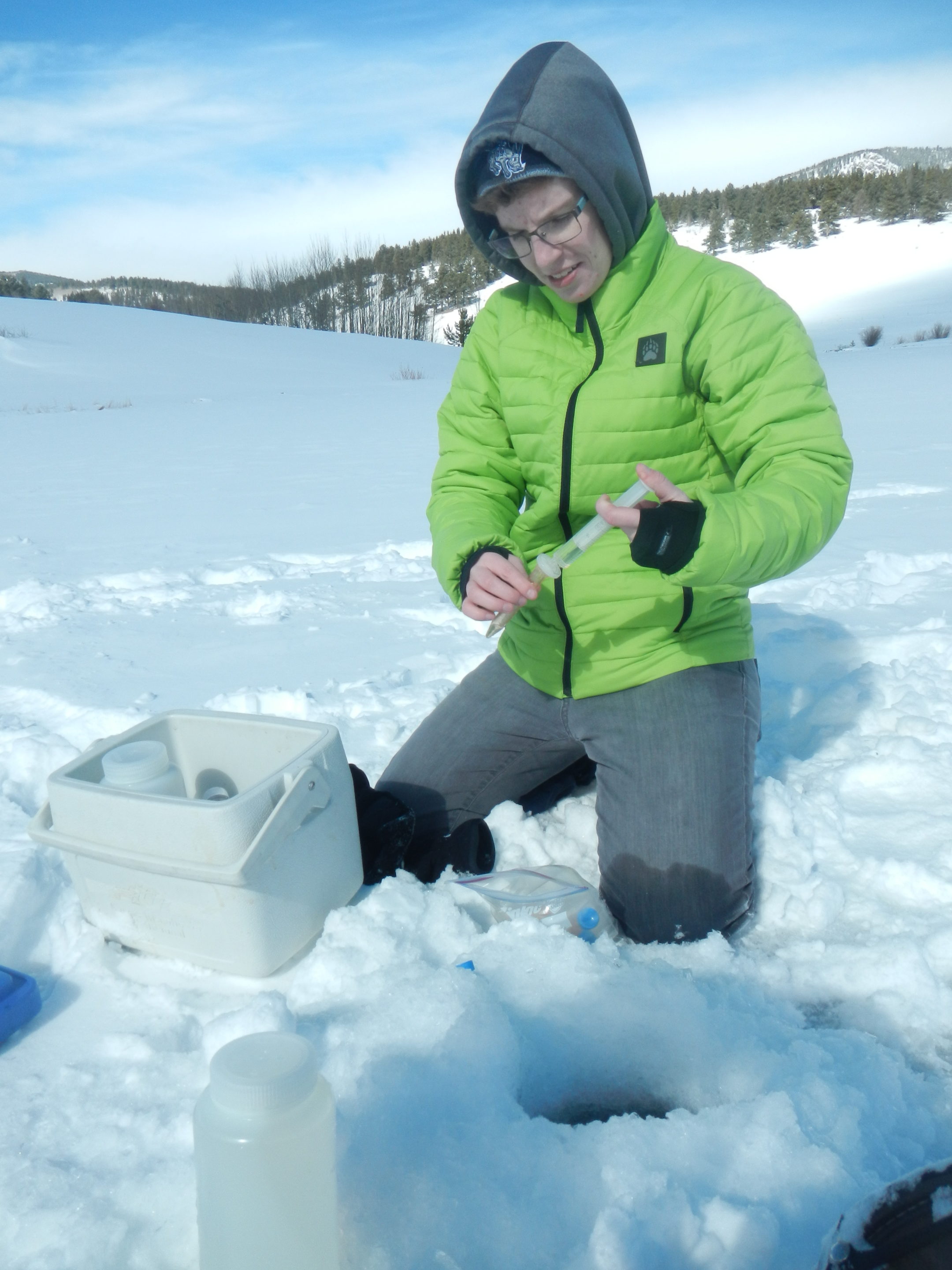
Design Solution
With the desired end goal of an ADA compliant, complete loop around Chase Gulch Reservoir in mind, the final design solution is proposed as a set of 4 phases to be completed over an extended period of time, as seen fit by Central City. A phase-by-phase financial analysis was also completed for this project. The costs were based on materials required and does not include costs for installation or labor.
Phase 1
Phase 1 acts as an initial set up for the end goal with the development of a partial loop that is more developed than the currently established path. The trail includes a section that is ADA accessible, although the entire trail is not. In preparation to eventually become entirely ADA accessible, the entire trail in Phase 1 is designed with the required rest stops and at a width, depth, and slope which would require minimal alteration to become ADA accessible. The material of the trail would also be a crushed gravel, which acts as the base level for a more stable surface such as concrete that would be required with ADA accessibility in future phases. One area of concern in the Phase 1 trail is at the northwest of the reservoir where the soil is more marsh-like. A boardwalk over this area resolves that concern. Also included in Phase 1 is a redesign of the parking lot at the site and the inclusion of port-a-potties, bear-proof waste bins, and informational signage.
Phase 2
Phase 2 achieves one aspect of the end goal by connecting the trail from Phase 1 into a complete loop around the reservoir. The ADA portion from Phase 1 remains untouched in Phase 2. The additional trail in Phase 2 is developed similarly to the non-ADA trail in Phase 1, thus requiring minimal alteration to become ADA compliant in the future. To have a complete loop, construction of a pedestrian bridge across the dam’s spillway is required. The recommended bridge type is a bowstring truss as it is a more cost effective bridge option for short span pedestrian bridges. This bridge requirement, along with more challenging natural slopes in the northeastern section of the reservoir area is why there are 2 phases to create the loop. This allows from costs to be spread out, creating more feasibility for funding to be granted.
Phase 3
Phase 3 of the proposed design calls for the entire loop to be made ADA accessible. Assuming the trail has already been predisposed to becoming ADA in the earlier phases, there should not be much land alteration required for this phase besides potential maintenance of the preexisting trail structure that may have degraded with time.
Phase 4
Phase 4 ultimately connects Chase Gulch Reservoir to the main, downtown Central City area. This phase is the development of a non-ADA trail on the eastern side of Apex Road which connects the loop at Chase Gulch Reservoir to the Prosser Trail. The Prosser Trail is a design proposed by students at the University of Colorado to develop a trail from downtown Central City to Russel Park. The trail proposed in Phase 4 would be a connection from that trail to the reservoir loop.
Next Steps
This project can be seen as a preliminary design approach for continued efforts of community development in Central City utilizing Chase Gulch Reservoir. The team has conducted an elevation and distance investigation of the site for the implementation of a trail around the reservoir. Further evaluation of construction requirements and detailed land alterations to implement these phases should be conducted to continue the efforts of this project. Costs and timeline for installation, labor and/or maintenance required for execution of each phase should also be further evaluated as only basic materials cost was detailed in this project. As Central City continues its community development these findings can be used as reference and can be expanded on in future projects.
Meet the Team
Gina Heinsohn
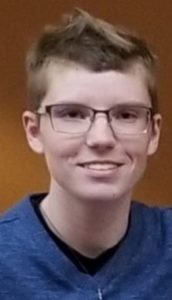 Gina Heinsohn is a graduating senior in Environmental Engineering. Originally from Chicago, they have fallen in love with Colorado and the various hiking trails scattered across the Denver area. Gina has always been passionate about the environment and about helping others. They were excited to get to apply both passions to this project and have greatly enjoyed working with Central City. Although not planning on continuing into the engineering field post graduation, Gina is still grateful for the skills gained from this project, such as communication and problem solving, that are transferable to any career choice.
Gina Heinsohn is a graduating senior in Environmental Engineering. Originally from Chicago, they have fallen in love with Colorado and the various hiking trails scattered across the Denver area. Gina has always been passionate about the environment and about helping others. They were excited to get to apply both passions to this project and have greatly enjoyed working with Central City. Although not planning on continuing into the engineering field post graduation, Gina is still grateful for the skills gained from this project, such as communication and problem solving, that are transferable to any career choice.
Annie Strange
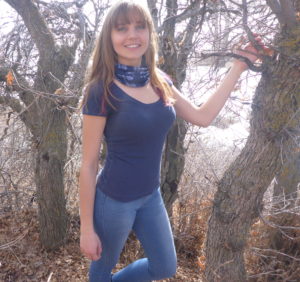 Annie Strange is an undergraduate senior in Environmental Engineering. She is a Colorado native that grew up with the Mines “M” in her backyard not knowing that that is where she would eventually sink her roots for her future. Her current studies are geared toward water treatment and sustainable engineering solutions. If she is free and the weather permits she will, most likely, be on a mountain somewhere. Annie would like to take her knowledge and passion for the outdoors to implement environmental solutions in underdeveloped regions of the world. She believes no sustainable project can be considered big or small; every environmental project solution makes a difference. Throughout her experience in the capstone design program she has learned the combination of work necessary to produce an effective product for a client. She has discovered that the design process can be different for every project or assignment. Therefore, acquiring new skills is an ongoing practice as an engineer, along with flexible and dynamic product design. While working with Central City Annie has learned additional ways that engineering partners can positively impact a community. As she goes forward in her career she is excited to turn her passion into reality, participating in sustainable projects with her developed abilities.
Annie Strange is an undergraduate senior in Environmental Engineering. She is a Colorado native that grew up with the Mines “M” in her backyard not knowing that that is where she would eventually sink her roots for her future. Her current studies are geared toward water treatment and sustainable engineering solutions. If she is free and the weather permits she will, most likely, be on a mountain somewhere. Annie would like to take her knowledge and passion for the outdoors to implement environmental solutions in underdeveloped regions of the world. She believes no sustainable project can be considered big or small; every environmental project solution makes a difference. Throughout her experience in the capstone design program she has learned the combination of work necessary to produce an effective product for a client. She has discovered that the design process can be different for every project or assignment. Therefore, acquiring new skills is an ongoing practice as an engineer, along with flexible and dynamic product design. While working with Central City Annie has learned additional ways that engineering partners can positively impact a community. As she goes forward in her career she is excited to turn her passion into reality, participating in sustainable projects with her developed abilities.
